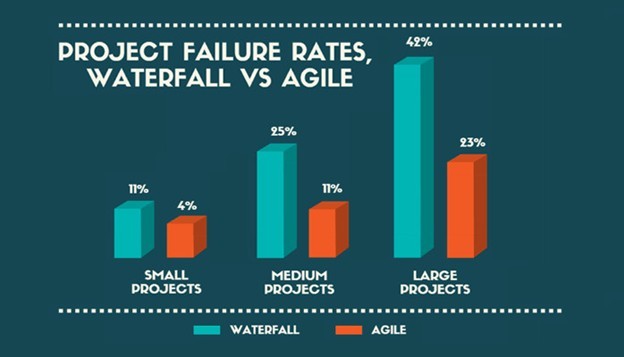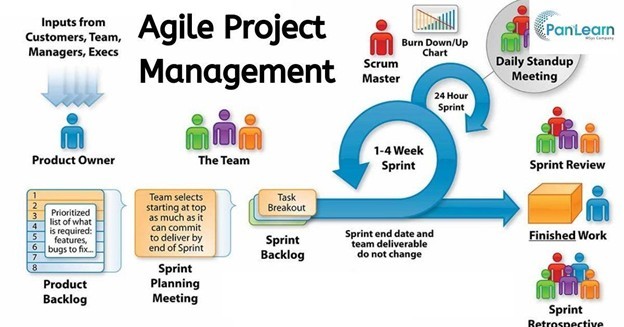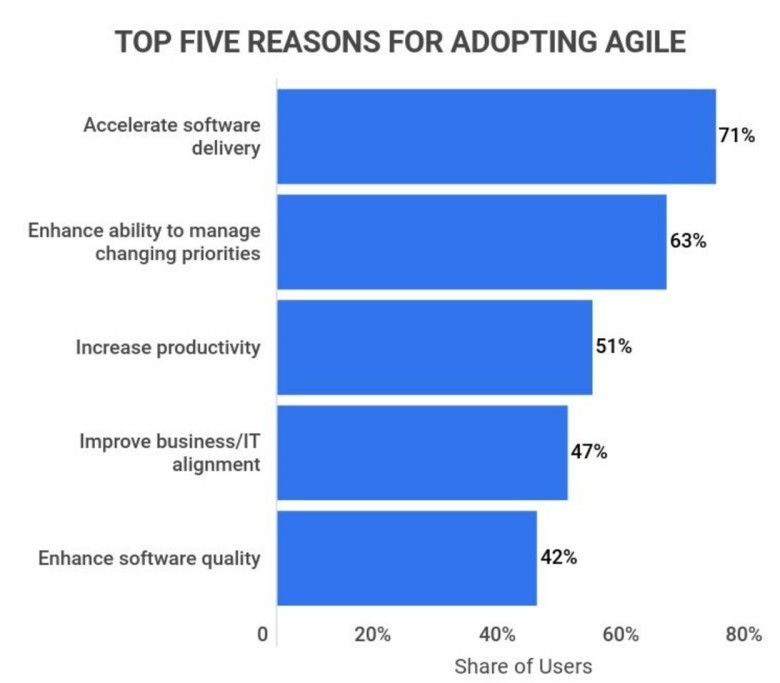views
In the world of project management, there exists a noticeable divide between those who favor traditional approaches and those who are more open to embracing the innovative agile methodology. The question stands: which one is best suited for your needs?
In this blog post, we will delve into the distinctions between these two methods, thoroughly examining their respective strengths and weaknesses. By gaining a comprehensive understanding of each approach, you will be empowered to make an informed decision regarding which strategy aligns best with your team's requirements.
Agile vs Traditional Project Management: An Overview
Traditional project management emphasizes a structured and sequential method, where each phase is meticulously planned and executed. On the other hand, agile project management prioritizes flexibility and adaptability, with an emphasis on collaboration and iterative development.

Traditional project management involves extensive planning with detailed timelines and milestones. The focus is on defining project scope, creating a schedule, and allocating resources. This approach works well for projects with clearly defined requirements and a stable environment. However, it may become rigid and inflexible when confronted with unexpected changes or evolving client needs.
In contrast, agile project management is founded on the principle of embracing change and working in iterations. The project is broken down into smaller, manageable tasks called sprints, with regular feedback loops. This approach enables teams to make quick adjustments and improvements throughout the project, allowing them to adapt to changing circumstances and deliver top-notch results. Agile proves particularly advantageous for complex projects that necessitate constant adaptation and collaboration.
Traditional project management offers predictability and stability by carefully planning and following a predefined path. This allows teams to effectively manage resources, meet deadlines, and mitigate risks. However, it can also result in rigidity and hinder innovation.
Agile project management brings enhanced flexibility and adaptability, allowing teams to efficiently respond to changes and deliver value. The regular feedback and continuous improvement fostered by the approach enable teams to be more efficient. However, one challenge of agile lies in its iterative nature, which can create uncertainty and make long-term schedule and budget management more complex.
What is Traditional Project Management?
Traditional project management is a long-standing approach that involves following a well-defined and step-by-step process to effectively manage projects. This method entails meticulous planning and execution in each phase of the project. The main focus lies in clearly defining the project scope, creating a comprehensive schedule, and appropriately allocating resources.
● Traditional project management follows a structured approach where projects are meticulously planned with predefined timelines and milestones. The objective is to establish a clear roadmap and ensure that all team members are well-informed about their roles and responsibilities. This approach works best for projects with clearly defined requirements operating in a stable environment.
● Traditional project management is known for its predictability and stability. By carefully planning and following a predefined path, teams can effectively manage resources, meet deadlines, and mitigate risks. This approach instills a sense of security and facilitates project tracking and documentation.
● Traditional project management also has some disadvantages. Its inflexible and rigid approach can make it challenging to adapt to unexpected changes or evolving client needs. If there are significant alterations in requirements or scope, the entire project plan may be disrupted, necessitating extensive rework.
● Moreover, the heavy emphasis on planning and structure in traditional project management approaches can sometimes stifle innovation and creativity. By sticking too closely to predefined pathways, there is limited room for exploring new ideas or adapting to unforeseen circumstances.
● Traditional project management offers a reliable and proven approach that brings stability and predictability. It works best for projects with clearly defined requirements and a stable environment. However, it may not be the most suitable choice when dealing with projects that require frequent changes or a high level of flexibility.
The Pros and Cons of Traditional Project Management
When deciding on an approach to project management, it is important for project managers to weigh the advantages and disadvantages of traditional methods.
● Traditional project management offers valuable benefits, such as predictability and stability. Through meticulous planning and adherence to a predefined path, teams can effectively manage resources, meet deadlines, and mitigate risks.
● This approach provides a sense of security while enabling improved project tracking and documentation.
● Additionally, it establishes a clear roadmap for all team members, ensuring that everyone understands their roles and responsibilities.
Traditional project management, while effective in many ways, does have its limitations.
● Its rigid and inflexible nature can make it difficult to navigate unexpected changes or evolving client needs.
● If there are significant changes in requirements or scope, it can disrupt the entire project plan and require extensive revisions.
● Furthermore, the focus on planning and structure may restrict innovation and creativity.
● Following a predefined path could hinder the exploration of new ideas or adaptability to changing circumstances, which could result in missed opportunities.
● One potential drawback of traditional project management is the possibility of delayed feedback and learning.
● Due to its linear process, feedback is usually collected at the end of each phase, which could result in missed chances to enhance and adjust throughout the project.
● Consequently, this may lead to less-than-optimal outcomes and impede efficient value delivery.
Traditional project management provides stability and predictability, making it a good choice for projects with clear requirements and a stable environment. However, it may not be the ideal approach for projects that require frequent changes or high flexibility. Project managers should carefully assess their project's unique needs and limitations before determining whether to adopt traditional project management or explore alternative methodologies such as agile.
What is Agile Project Management?
Agile project management is a modern and adaptable approach to project management that emphasizes teamwork, flexibility, and an iterative development process. Unlike traditional project management methods that follow a rigid and sequential framework, agile project management embraces change and prioritizes delivering value in smaller, incremental stages.

In agile project management, the project is broken down into smaller tasks called sprints. Each sprint has a specific objective and timeframe, typically ranging from one to four weeks. The project team works closely together, holding regular meetings to review progress, address obstacles, and plan for the next phase. This ongoing feedback loop enables prompt adjustments and enhancements throughout the project duration.
A crucial principle of agile project management is its capacity to adapt to changing circumstances and evolving client needs. Unlike traditional project management, which can be rigid and inflexible, agile enables swift adaptation and course correction. This flexibility is particularly significant in today's dynamic business environment, where requirements often undergo rapid changes.
Agile project management has a notable strength in its emphasis on collaboration. By bringing together team members from various disciplines and fostering cross-functional cooperation, agile project management fosters innovation and creativity. This approach facilitates more effective problem-solving and enables the delivery of high-quality results.
Despite its benefits, agile project management also poses challenges. The iterative approach can introduce uncertainty and make it harder to manage long-term schedules and budgets. Moreover, the emphasis on collaboration and frequent communication necessitates strong coordination and teamwork.

Agile project management provides enhanced flexibility and adaptability, making it well-suited for complex projects that demand continual adjustment and collaboration. By embracing change and working in iterations, agile project management empowers teams to address evolving client requirements and deliver value more effectively. However, for projects with clearly defined requirements and a stable environment, traditional project management may be a better fit.
The Pros and Cons of Agile Project Management
Agile project management has brought a refreshing approach to the world of project management. It has revolutionized how teams tackle complex projects by prioritizing flexibility, collaboration, and iterative development. However, like any methodology, it is important to consider its pros and cons before fully embracing the agile approach.
● Agile project management offers a significant advantage in its adaptability to change. In today's fast-paced business world, requirements can shift and develop rapidly.
● Agile enables teams to swiftly adjust and make necessary changes without disrupting the entire project. This means that even if client needs change midway through, agile teams can quickly pivot and continue delivering value.
● By bringing together team members with diverse expertise and fostering cross-functional collaboration, agile promotes innovation and creativity.
● This collaborative approach enhances problem-solving abilities and facilitates the delivery of high-quality results.
While agile project management offers benefits, it also poses challenges.
● The iterative approach of agile can introduce uncertainty and make it difficult to manage schedules and budgets in the long term.
● Each sprint has a specific goal and timeframe, making long-term planning challenging, particularly for organizations that heavily rely on strict timelines and budget constraints.
● Furthermore, the focus on collaboration and regular communication necessitates strong coordination and teamwork. This implies that teams need reliable channels of communication to ensure alignment and collective progress towards shared objectives.
Agile project management provides enhanced flexibility and adaptability, making it ideal for complex projects that demand continuous adjustment and collaboration. By embracing change and working in iterations, agile project management empowers teams to promptly address evolving client requirements and deliver value more efficiently. Nonetheless, it may not be the most suitable approach for projects with well-defined requirements and a stable environment where traditional project management methods could be more appropriate.
Factors to Consider When Choosing between Agile and Traditional PM
When choosing between agile and traditional project management, it's important to consider various factors. Both approaches have their own advantages and disadvantages, and having a clear understanding of these can guide you in selecting the most suitable method for your team and projects.
When deciding on a project management approach, it's crucial to first consider the nature of your project. For projects with clear requirements and a stable environment, traditional project management might be the best choice. This approach, with its structured and sequential methodology, offers stability and predictability. It enables effective resource management, timely delivery, and risk control.
However, if your project involves frequent changes, collaboration, and adaptation, agile project management may be the more suitable choice. Agile emphasizes flexibility and iterative development, enabling you to promptly respond to evolving client requirements. The adaptable nature of agile methodology can be particularly advantageous for complex projects that necessitate continuous adjustment.
The level of innovation and creativity needed for your project is another important consideration. Traditional project management, which focuses on following a set path, may hinder your ability to explore new ideas and adapt to changing situations. On the other hand, agile project management encourages collaboration and cross-functional teamwork, fostering innovation and creative problem-solving.
It's also important to consider the level of control and documentation required for your project. Traditional project management offers a structured roadmap that allows for thorough project tracking and documentation. This can be particularly helpful for projects that require strict control and extensive documentation. On the other hand, Agile project management, while still providing documentation and tracking, may not offer the same level of control and rigidity as traditional approaches.
How to Decide Which One Is Right for You?
When deciding between agile and traditional project management, it is important to consider several key factors to determine which approach best suits you and your team.
Before deciding on a project management approach, consider the nature of your project. If you have clearly defined requirements and a stable environment, traditional project management may be suitable. Its structured and sequential approach offers stability and predictability, ensuring efficient resource management, meeting deadlines, and mitigating risks. However, if your project requires frequent changes, adaptability, and collaboration, agile project management may be more appropriate. Agile embraces change and emphasizes iterative development to quickly respond to evolving client needs.
The level of innovation and creativity required for your project is also crucial to consider. Traditional project management, which focuses on following a predetermined plan, may restrict your ability to explore new concepts and adapt to changing situations. In contrast, agile project management encourages collaboration and cross-functional teamwork, nurturing innovation and creative approaches to problem-solving.
Additionally, it's important to consider the level of control and documentation necessary for your project. Traditional project management offers a structured roadmap that facilitates effective project tracking and documentation. This can be particularly advantageous for projects that require stringent control and extensive documentation. On the other hand, Agile project management, while still offering documentation and tracking, may not offer the same degree of control and rigidity as traditional methods.
Deciding whether to use agile or traditional project management ultimately depends on the specific needs and limitations of your project. Consider factors such as the nature of the project, the level of required innovation, documentation and control requirements, and the necessary level of flexibility and collaboration. By thoughtfully evaluating these aspects, you can make an informed decision about which approach best suits your team and project.
Conclusion
In conclusion, the decision between agile and traditional project management is not a universal choice. Each approach has its own advantages and disadvantages, and the best option depends on the specific requirements of your team and projects.
If you prefer stability, predictability, and a clearly defined path, traditional project management might be the right choice for you. This approach offers a straightforward roadmap, enables better project monitoring, and works well for projects with clearly established requirements and a stable environment. However, it's important to keep in mind that traditional project management can be inflexible when confronted with unforeseen changes or evolving client demands.
However, if you value flexibility, adaptability, and ongoing collaboration, agile project management might be a more suitable choice. Agile embraces change and emphasizes iterative development, enabling teams to respond rapidly to evolving client requirements. By breaking projects into smaller sprints and incorporating frequent feedback loops, agile facilitates adjustments and delivers high-quality results more efficiently. It is important to note that the iterative nature of agile may introduce some uncertainty and challenges in managing long-term schedules and budgets.
In the end, selecting the appropriate approach depends on a thorough assessment of your project's characteristics. Take into account factors such as the level of innovation necessary, documentation and control requirements, and the degree of collaboration and flexibility needed. By considering these aspects and understanding the advantages and limitations of each method, you will be able to make an informed decision that aligns with your team's objectives and goals.
When it comes to project management, it's crucial to recognize that the field is ever-changing. What may be effective for one project might not necessarily apply to another. That's why it’s essential to continuously assess and adjust your approach based on the unique requirements of your team and the evolving demands of each project.
In summary, the key to successful project management lies in finding the right balance between agile and traditional approaches. It's important to empower your team and prioritize their success. So, take a confident step forward, choose the method that aligns with your values and goals, and witness the growth of your projects and web development company in the UK. Cheers to effective project management!






















Comments
0 comment